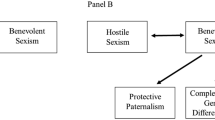Abstract
An analysis of the Bem Sex Role Inventory (BSRI) was conducted to determine (1) whether the instrument is a valid indicator of current cultural definitions of masculinity/femininity, and (2) whether cultural definitions of masculinity/femininity, as indicated by the BSRI, differ between various cultural groups—specifically, African-American, Anglo, and Hispanic. Results indicate that the B[R]SRI, within limits, appears to still be a valid indicator of “American” cultural definitions of masculinity and femininity. However, the scale was found to be less valid as a measure of M/F among Hispanic-American and African-American subjects. The study calls for the development of culture-specific sex role inventories for use among non-Anglo segments.
Similar content being viewed by others
References
Albert, A. A., & Porter, J. R. (1988) Children's gender-role stereotypes: A sociological investigation of psychological models.Sociological Forum, 3 184–210.
Antill, J. K., Cunningham, J. D., Russell, G., & Thompson, N. L. (1981). An Australian sex role scale.Australian Journal of Psychology, 33 169–183.
Ballard-Reisch, D., & Elton, M. (1992). Gender orientation and the Bem Sex Role Inventory: A psychological construct revisited.Sex Roles, 27 291–306.
Bardwell, J., Cochran, S., & Walker, S. (1986). Relationship of parental education, race, and gender to sex role stereotyping in five-year-old kindergartners.Sex Roles, 15 275–81.
Bem, S. L. (1974). The measurement of psychological androgyny.Journal of Consulting and Clinical Psychology, 42 155–162.
Bem, S. L. (1979). Theory and measurement of androgyny: A reply to the Pedhazur-Tetenbaum and Locksley-Colten critiques.Journal of Personality and Social Psychology, 37 1047–1054.
Bem, S. L. (1981a).Bem Sex Role Inventory: Professional manual. Palo Alto, CA: Consulting Psychologists Press.
Bem, S. L. (1981b). Gender schema theory: A cognitive account of sex-typing.Psychological Review, 88 354–364.
Berzins, J. I., Welling, M. A., & Wetter, R. E. (1978). A new measure of psychological androgyny based on the personality research form.Journal of Clinical and Consulting Psychology, 46 126–138.
Bird, H., & Canino, G. (1982). The Puerto Rican family: Cultural factors and family intervention strategies.Journal of the American Academy of Psychoanalysis, 10 257–268.
Edwards, A. L., & Ashworth, C.D. (1977). A replication study of item selection for the Bem Sex Role Inventory.Applied Psychological Measurement, 1 501–507.
Epstein, C. F. (1973). Positive effects of the multiple negative: explaining the success of black professionals.American Journal of Sociology, 78 912–935.
Erkison, E. H. (1968).Identity: Youth and crisis. New York: Norton.
Gaudreau, P. (1977). Factor analysis of the Bem Sex Role Inventory.Journal of Consulting and Clinical Psychology, 45 299–302.
Hondagneu-Sotelo, P. (1992). Overcoming patriarchal constraints: The reconstruction of gender among Mexican immigrant women and men.Gender and Society, 6 393–415.
Hunter, A. G., & Davis, J. E. (1992). Constructing gender: An exploration of Afro-American men's conceptualization of manhood.Gender and Society, 6 464–479.
Kagan, J. (1964). Acquisition and significance of sex typing and sex role identity. In M. L. Hoffman & L. W. Hoffman (Eds.),Review of child development research. New York: Russell Sage Foundation.
Kochman, T. (1981).Black and white styles in conflict. Chicago: University of Chicago Press.
Kranau, E. J., Green, V., & Valencia-Weber, G. (1982). Acculturation and the Hispanic woman: Attitudes, sex role behavior, and demographics.Hispanic Journal of Behavioral Sciences, 4 21–40.
Kutsche, P. (1983). Household and family in Hispanic Northern New Mexico.Journal of Comparative Family Studies, 14 151–165.
Ladner, J. A. (1972).Tomorrow's tomorrow: The black woman. Garden City, NY: Doubleday.
Lewis, D. K. (1975). The black family: Socialization and sex roles.Phylon, 36 221–237.
Millham, J., & Smith, L. E. (1981). Sex role differentiation among black and white Americans: A comparative study.The Journal of Black Psychology, 7 77–90.
Moreland, J. R., Gulanick, N., Montague, E. K., & Harren, V. A. (1978). Some psychometric properties of the Bem Sex Role Inventory.Applied Psychological Measurement, 2 249–256.
Parker, G. V. C. (1969). Sex differences in self-description on the Adjective Check List.Educational and Psychological Measurement, 29 99–113.
Pedhazur, E. J., & Tetenbaum, T. J. (1979). Bem Sex Role Inventory: A theoretical and methodological critique.Journal of Personality and Social Psychology, 37 996–1016.
Pettigrew, T. F. (1964).A Profile of the Negro American. Princeton, NJ: Van Nostrand Reinhold.
Rosario, L. (1982). The self-perception of Puerto Rican women toward their societal roles. In R. E. Zambrana (Ed.),Work, family and health: Latino women in transition. New York: Hispanic Research Center.
Smith, P. A., & Midlarsky, E. (1985). Empirically derived conceptions of femaleness and maleness: A current construct.Sex Roles, 12 313–328.
Stevens, E. P. (1973). Machismo and marianismo.Society, 10 57–63.
Tzuriel, D. (1984). Sex role typing and ego identity in Israeli, Oriental, and western adolescents.Journal of Personality and Social Psychology, 46 440–457.
Vega, W. A. (1990). Hispanic families in the 1980s: A decade of research.Journal of Marriage and the Family, 52 1015–1024.
Wong, F. Y., McCreary, D. R., & Duffy, K. G. (1990). A further validation of the Bem Sex Role Inventory: A multitrait-multimethod study.Sex Roles, 22.
Young, V. H. (1970). Family and childhood in a southern negro community.American Anthropologist, 72 269–288.
Author information
Authors and Affiliations
Rights and permissions
About this article
Cite this article
Harris, A.C. Ethnicity as a determinant of sex role identity: A replication study of item selection for the Bem Sex Role Inventory. Sex Roles 31, 241–273 (1994). https://doi.org/10.1007/BF01547717
Issue Date:
DOI: https://doi.org/10.1007/BF01547717




